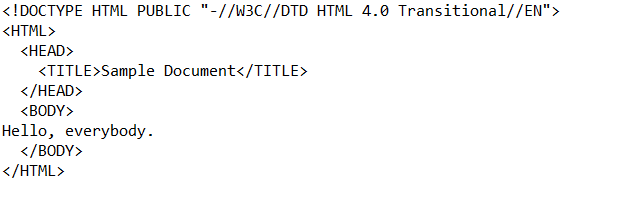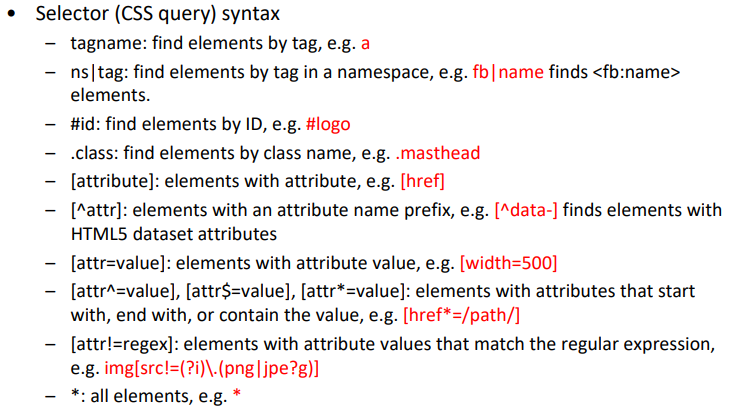Reading contents from an HTML file
우리는 데이터를 URL로 부터 읽어들일 수 있다. 이 과정은 파일로 부터 데이터를 읽어오는 것과 매우 유사하다.
URL url = null;
BufferedReader input = null;
//특정 위치의 html파일을 읽어오기
String address = "<https://icslsogang.github.io/courses/cse3040/hello.html>";
String line = "";
try {
url = new URL(address);
input = new BufferedReader(new InputStreamReader(url.openStream()));
while((line=input.readLine()) != null) {
System.out.println(line);
}
input.close();
} catch(Exception e) {
e.printStackTrace();
}
Plain Text
복사
위와 같이 URL에서 가져온 파일을 읽어들일 수 있다는 것을 확인할 수 있다.
Downloading a file from a URL
URL url = null;
InputStream in = null;
FileOutputStream out = null;
// 읽고자 하는 것이 jpg 파일인 경우
String address = "<https://icslsogang.github.io/courses/cse3040/sogang_campus.jpg>";
int ch = 0;
try {
url = new URL(address);
// 이 방식으로 inputStream처럼 만들 수 있다.
in = url.openStream();
// 아래의 파일에 이미지를 씌우겠다는 의미
out = new FileOutputStream("sogang_campus.jpg");
while((ch=in.read()) != -1) {
out.write(ch);
}
in.close();
out.close();
} catch(Exception e) {
e.printStackTrace();
}
System.out.println("File download complete.");
Plain Text
복사
Parsing an HTML File
public class Lecture {
static ArrayList<String> lines = new ArrayList<String>();
public static void main(String[] args) {
URL url = null;
BufferedReader input = null;
// 교보문고의 베스트셀러들을 보여주는 페이지가 파일로 되어 있다.
String address = "<http://www.kyobobook.co.kr/bestSellerNew/bestseller.laf>";
String line = "";
// 베스트 셀러의 제목을 앍아내기
try {
url = new URL(address);
input = new BufferedReader(new InputStreamReader(url.openStream()));
// 일단 읽어들여서 Line by Line으로 저장한다.
while((line=input.readLine()) != null) {
if(line.trim().length() > 0) lines.add(line);
}
input.close();
} catch(Exception e) {
e.printStackTrace();
}
int rank = 1;
int status = 0;
// 한줄씩 가지고 오면서 데이터를 분석한다.
for(int i=0; i<lines.size(); i++) {
String l = lines.get(i);
if(status == 0) {
if(l.contains("div class=\\"detail\\"")) status = 1;
} else if(status == 1) {
if(l.contains("div class=\\"title\\"")) status = 2;
} else if(status == 2) {
if(l.contains("a href")) {
int begin = l.indexOf("<strong>") + "<strong>".length();
int end = l.indexOf("</strong>");
System.out.println(rank + "위: " + l.substring(begin, end));
status = 0;
rank++;
}
}
}
}
}
Plain Text
복사
Parsing an HTML file using jsoup
jsoup : Java 외부 라이브러리로 HTML 로 부터 데이터를 뽑아내거나 복제하는데 편리하다.
https://jsoup.org/download
jsoup을 build Path의 Add External Archives를 통해 추가시키면 사용이 가능하다. 하지만 여기에서 중요한 것이 만약 이전에 Module-info를 한 번이라도 만들었다면 문제가 생길 수 있다. 그렇게 때문에 이것을 미리 프로젝트에서 삭제해주어야 한다.
jsoup을 사용하면 아래와 같이 쫌 더 짧아지고 원하는 결과물을 구해낼 수 있다.
import java.io.IOException;
import org.jsoup.Jsoup;
import org.jsoup.nodes.Document;
import org.jsoup.select.Elements;
public class Lecture {
public static void main(String[] args) throws Exception {
String url = "<http://www.kyobobook.co.kr/bestSellerNew/bestseller.laf>";
Document doc = null;
// url에 접속한다.
try {
doc = Jsoup.connect(url).get();
} catch(IOException e) {
System.out.println(e.getMessage());
}
// select를 사용해서 doc에서 이 태그가 나오는 부분을 찾아준다. 그래서 이것을 bestsellers에 넣어준다.
//그래서 div detail 부분의 모든 element를 가지고 온다.
Elements bestsellers = doc.select("div.detail");
// bestseller로 가져온 것중에 div title 부분만 가져온다.
Elements titles = bestsellers.select("div.title");
// title 내부의 href 태그만 가져온다.
Elements booktitles = titles.select("a[href]");
// for을 이용해서 meta-data가 아닌 부분만 출력하게 한다.
for(int i=0; i<booktitles.size(); i++) {
System.out.println(i+1 + "위: " + booktitles.eq(i).text());
}
}
}
Plain Text
복사
try {
doc = Jsoup.connect(url).get();
} catch(IOException e) {
System.out.println(e.getMessage());
}
Plain Text
복사
MalformedURLException, HttpStatusException, UnsupportedMimeTypeException,
SocketTimeoutException, IOException와 같은 에러가 생길 수 있는데, IOException이 최상위 개념이다.
위의 메뉴얼은 jsoup에서 가져올 수 있는 데이터들의 종류들이다.



